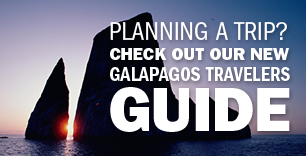Search
Tag Cloud
Subscribe
Packing for a Galapagos Adventure, Part I: Clothing

Packing for a new adventure is always exciting. And the anticipation seems to grow with every item you carefully place in your suitcase.
I remember being in that happy state while I was getting ready for my first visit to the Galapagos Islands. Usually a traveler to Earth’s cold places, I knew that this equatorial journey was truly going to be a wild exploration for me, one out of my comfort zone. I had little knowledge about what to take to a warm destination, but I guessed I’d need several lightweight shirts and pairs of shorts, and I checked to make sure that I had my sunglasses and a swimsuit.
On the surface, it sounded pretty easy: no parkas, snow boots or thermal layers—the kind of stuff I was used to hauling around. In reality, however, certain places in the Galapagos Islands can be chilly at night during particular times of the year, and protecting yourself from the sun can be just as challenging as insulating yourself against the cold. (I’m still wondering how the Galapagos Islands sun managed to find the very narrow strips of skin between the top straps of my sandals to target for burning!)
Making sure that you’re taking along the right items on your own Galapagos tour will help you avoid some discomforts and guarantee that you’ll have the best experience possible. Below, you’ll find some packing guidelines for clothing to assist you in making sure that you’re well prepared for the adventure that awaits!

Baggage allowances and luggage requirements
Before choosing your suitcase, check the baggage allowances and luggage requirements (size and weight limitations) for your flights to the Galapagos. If you’ll be going on a Galapagos cruise, your cabin may be very small, and you won’t want to take up precious space with lots of large luggage. Some ships cannot accommodate hard-sided suitcases, so pack your gear in a soft-sided, collapsible, duffle-type bag that can be stored away easily.
Some travelers pack their clothes rolled up in freezer bags. This technique makes folding clothes unnecessary and prevents wrinkling, and it offers a kind of vacuum-sealing to save space in the suitcase. Later, the bags can be used to provide some protection for personal items, such as electronics (for example, cameras or phones), that could easily get wet or damaged if not in a water-repellent casing.
Comfortable clothing and water wear
Here’s a listing of the clothing you’re likely to need on your Galapagos adventure:
1) Hiking boots, hiking shoes or trail runners. Bring comfortable hiking (or walking) boots or shoes with good traction. You could be walking on sandy, rocky, uneven and wet, slippery terrain all during a single site visit. So, if you tend to lose your balance occasionally, pack a taller hiking boot with ankle support. If you’re sure-footed, a space-saving, lightweight, breathable trail runner with superior gripping power may be all you need.
2) Sport sandals or water shoes. Water-resistant sport sandals (such as Chacos, Keens or Tevas) are highly recommended for getting in or out of the pangas during wet landings. It’s suggested that you not go barefoot while wading in the water, as the sharp coral can cut like glass. Flip-flops are inadvisable.
3) Boat (deck) shoes. The soles of your hiking shoes will often be dirty after island excursions; so to keep your yacht clean, outfitters ask that you bring a light pair of rubber-soled deck or boat shoes to wear while lounging on the ship.
4) Thin and breathable hiking socks. Bring enough pairs of comfortable, lightweight hiking socks to last for the entire duration of your Galapagos trip. The islands can get pretty warm during the hot/rainy season (January through June), so materials such as COOLMAX are recommended for their breathability properties. You may also want to consider bringing some pairs of waterproof socks.
5) Hiking shorts and full-length pants. Two to three pairs of lightweight hiking shorts, quick-drying if possible, are ideal for the warm days. Two pairs of full-length pants, either synthetic or cotton—such as jeans—will work well for cooler walks in the highlands or for use at night. Select lighter colors to avoid unnecessary heating due to light absorption.
6) T-shirts/safari shirts/long-sleeved shirts. Breathability and moisture-wicking are the most important features to consider when choosing your tops. While short sleeves are great for hot days, you’ll want a long-sleeved shirt for the cooler days and evenings, and also for sun protection. It’s best to opt for neutral tones for your six to eight shirts, as bold colors, such as black, red and yellow, may attract wasps.
Some suggest trying breathable, odor-resistant merino wool. It seems counterintuitive, but wool keeps you cool when it’s hot and warm when it’s cold. When it gets wet, you’ll stay warm until your clothing dries. It naturally resists the growth of fungus and bacteria, so it never develops an odor. It’s even flame-retardant. Performance wool isn’t like the itchy wool of the past—it’s thin, stretchy and supersoft.
7) Jackets: a lightweight fleece jacket and a rain jacket with a hood. A lightweight, fleece jacket or sweatshirt will come in handy to wear on the plane, in the Ecuadorian highlands and to slip on after a full day of swimming in the chillier waters (July through December). The hottest months are usually February through April and the coolest are August through October. From July through the fall, it can be cool and foggy in the very early morning hours when setting out on landings. Occasionally, you will experience breezes as you sail from one location to another in the evening.
And, as the rainy season in the Galapagos lasts from January through June, you’ll want to bring rain protection if visiting during that time. Your waterproof jacket can also work as a windbreaker at any time of year.
8) Sleepwear. Whatever you usually sleep in will probably be fine, but something light will be more comfortable.
9) Underwear. You most likely have your own preferences, but underwear made from synthetics and synthetic blends will dry out more quickly.
10) Headgear: a wide-brimmed hat with a chinstrap and a bandana or BUFF to protect your neck. Wide-brimmed hats (the panama hat was actually invented in Ecuador) and hiking caps with neck-shading back flaps are the preferred headgear. Light, breathable bandanas will also work to shield your neck from the sun.

11) Swimsuits, cover-ups and/or swim shirts (or rash guards). Bring along two swimsuits so that you can snorkel daily and let one dry from the previous day’s activities. A cover-up, such as a caftan, is great for lounging on the ship’s decks.
If you don’t like to wear sunscreen, a lightweight swim shirt, rash guard (an athletic shirt made of spandex and nylon or polyester) or merino wool shirt will protect your skin from the sun and provide insulation.
12) Wet suit and snorkeling equipment. If you have your own snorkeling equipment and you feel like bringing it with you, do so by all means. Often it is better to have your own equipment with which you are comfortable and certain of the fit. However, most ships will supply it. Optional items include a swim cap or BUFF to wear over your head during the colder months, snorkeling gloves, and booties or long socks to ward off sunburn and keep your legs and feet warm while snorkeling.
13) Paddling gloves. If you plan to kayak, you may want to use paddling gloves to prevent blisters and protect against sunburn.

What not to pack and what to wash away
When you’re on any trip, it’s always best to leave expensive jewelry at home. But the Galapagos Islands have some other important “don’t-bring-alongs.”
The introduction of non-native plant species is considered a top environmental threat to the Galapagos Islands, so do not bring any fruits, plants or vegetables with you. Anything that might have seeds or spores clinging to it, such as the soles of your shoes and any camping equipment or outdoor gear, should be washed and inspected thoroughly before bringing it to the islands.
This list of apparel should ensure that you’ll always have the right wardrobe at your fingertips for whatever nature and the Galapagos have in store for you during your visit.
Next, we’ll dive into the other items you’ll want to be sure to have on hand during your Galapagos Islands adventure.
Here’s to those who cannot live without wild things,
Candy
Feature image: Some of the sand in the Galapagos is made up of sharp coral that can cut like glass. It’s best not to go barefoot while wading in the water or while hiking.








